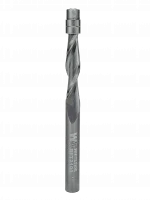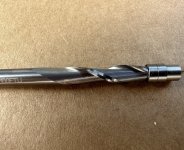I am making some toy cars. I am using a scroll saw to come within 1/8” to 1/16” of the pattern. I then attach the pattern to the blank and using a bearing guided pattern/template router bit, I finish the cut.
The bit is little used and feels sharp. But I am getting a ragged edge as indicated in the photo below. I am referring to the area adjacent to the blue tape.
I never work in pine (except to use framing studs), but this result seems wrong. This stock is 3/4” thick. The pattern is 1/2” thick.
Before I order a replacement bit, I want to confirm that the bit is the culprit.
Other possibilities are technique. I am feeding fairly quickly to avoid burn marks on the wood. Are the burn marks a product of a dull bit?
Despite my best efforts, a burn mark is visible at the front of the car.
And the only other possibility I can think of, is that pine is susceptible to this tearing. My cross cuts (with a sharp blade on my table saw) see rougher than usually edges.
And a new finding for me, is a different type of kickback on the table saw with pine. I got I hit in the stomach with a kicked back half of a loose knot. No pain or bruise, but a what-the-heck-was-that response.
If it is the bit at fault, I would like to order it today. If it is a mea culpa and I’m at fault, then I’d like to get the embarrassment over today also.
Most of my recent (within the last 10 years) purchase of bits have been from Whiteside. I’m not sure of the manufacturer of this bit. It is older but rarely used. It is probably a Craftsman bit, so no telling who actually made it.

The bit is little used and feels sharp. But I am getting a ragged edge as indicated in the photo below. I am referring to the area adjacent to the blue tape.
I never work in pine (except to use framing studs), but this result seems wrong. This stock is 3/4” thick. The pattern is 1/2” thick.
Before I order a replacement bit, I want to confirm that the bit is the culprit.
Other possibilities are technique. I am feeding fairly quickly to avoid burn marks on the wood. Are the burn marks a product of a dull bit?
Despite my best efforts, a burn mark is visible at the front of the car.
And the only other possibility I can think of, is that pine is susceptible to this tearing. My cross cuts (with a sharp blade on my table saw) see rougher than usually edges.
And a new finding for me, is a different type of kickback on the table saw with pine. I got I hit in the stomach with a kicked back half of a loose knot. No pain or bruise, but a what-the-heck-was-that response.
If it is the bit at fault, I would like to order it today. If it is a mea culpa and I’m at fault, then I’d like to get the embarrassment over today also.
Most of my recent (within the last 10 years) purchase of bits have been from Whiteside. I’m not sure of the manufacturer of this bit. It is older but rarely used. It is probably a Craftsman bit, so no telling who actually made it.



